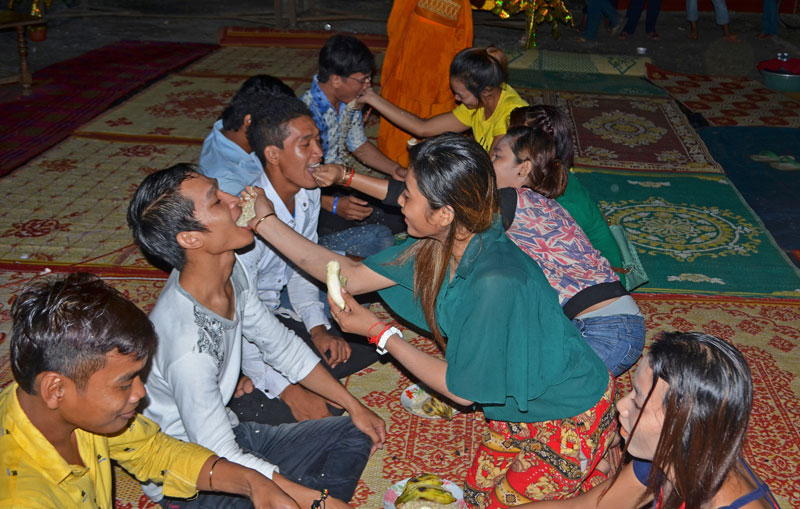TRENG TRAYOENG COMMUNE, Kompong Speu – As thousands of people descended on Phnom Penh for the return of the Water Festival this week, about 300 villagers in Kompong Speu stayed closer to home to celebrate two Buddhist rituals on Thursday night.
Ak Ambok and Sampeah Preah Khe, which translate as “offering pounded rice” and “paying respects to the moon,” were once celebrated in pagodas across the country on the night of the full moon that falls during the Water Festival.

But the tradition is slowly fading away, members of the Buddhist clergy say. This year, only a handful of pagodas in Phnom Penh staged the rituals, and they were held in only a smattering of pagodas in the provinces.
Ak Ambok and Sampeah Preah Khe derive from a legend that Buddha was once incarnated as a rabbit named Pouthesat, who sacrificed himself for a hungry god by jumping into a fire during a full moon. Bananas, sweet potatoes, yams, coconuts and pounded new rice are offered to the rabbit Buddha.
As the rituals’ appeal has waned among younger generations in recent decades, monks at Treng Trayoeng pagoda in Phnom Sruoch district’s Treng Trayoeng commune have been forced to resort to some unorthodox methods to entice the local youth, such as playing loud pop music through speakers.
“I am really worried we will lose this tradition,” said Nou Chin, chief monk at the pagoda, his voice competing with bass lines blaring from the sound system.
“We use this music to attract the younger members of the community. Once they are here, we can stop it and then explain about these traditions,” he said
“It’s like fishing: If you don’t put bait on the hook you will not catch any fish.”
Perhaps because of his extraordinary efforts, Thursday night saw a healthy turnout of revelers, many of whom were local youth. Beginning at about 6 p.m., the festivities included a mixture of past and present traditions, as some youngsters tried their hands at traditional rice pounding while others took to the dance floor and bought raffle tickets in hopes of winning a cash prize.
At one point, there was a three-way battle for the airwaves, with a monk giving blessings over one sound system and traditional Cambodian music coming from speakers outside the pagoda, while techno music blared from the dance floor.
Nget Chanbo, chief of the religion department at the Ministry of Cults and Religion, said based on his own observations, about 60 percent of pagodas still hold small Sampeah Preah Khe and Ak Ambok ceremonies, but he said the number was on the decline.
“People are not practicing the ceremony [in pagodas] as much because people lost their faith because there are some monks involved in politics,” he said.
“The people’s beliefs are less strong because they are influenced by other cultures and different religions such as Christianity and Islam…who use money to attract people, but with Buddhism you either believe or you don’t,” added Mr. Chanbo.
The dance floor had been in full swing for about three hours at 10 p.m. when the speakers were cut and about a third of the revelers sat down on mats for a blessing. The chief monk then gave a brief sermon explaining in detail the meaning of the ceremony.
Soon after came the candle burning ceremony, when five candles representing Kompong Speu and four neighboring provinces were attached to a wooden beam and rotated until they sputtered out. The chief monk then examined the pattern of candle wax drips and the speed with which the candles burned out to make predictions for the coming year’s weather and general luck.
Kompong Speu burned out fast, indicating heavy rainfall early in the year. Nou Chin asked the onlookers what they thought the province’s candle wax drips looked like.
“A beetle!” somebody shouted, prompting giggles among the crowd. The chief monk laughed too, but then considered the wax more closely.
“I think it looks like a stream and a dam, so it means that our Kompong Speu province will have a good year of rice next year,” he told the crowd.
The most animated part of the night was Ak Ambok, where young men and women are paired up in lines and made to feed their partner as much ambok, or pounded dry rice flakes, as they can stomach. They also stuff bananas and coconut into each other’s faces—anything that a rabbit might like to eat is fair game.
The tradition is lighthearted, but it has a serious purpose, bringing the community together at the start of the rice-harvesting season to celebrate the fruitfulness of the land and the rains of the past six months, and look ahead to the coming harvest. Ambok is usually made from the new grains of “srov domnerp,” or glutinous rice, just after they sprout.
Koy Hon, 53, said she attends the ceremony at Treng Trayoeng pagoda every year and particularly loves preparing ambok, but was worried that the tradition would soon be lost.
“If I had money, I would buy more giant wooden mortars to make ambok and show the young people,” she said. Catching sight of a group of children and teenagers nearby who were attempting to pound the new rice into flakes of ambok, she shouted, “Hey, don’t do like that, it is not correct!” Ms. Hon rushed off to show them the correct way to wield the wooden pestle.
“I’m worried that it will be lost one day and my children won’t even know what rice is,” she said after returning from her impromptu demonstration.
After one last blessing, the older and middle-aged villagers began mounting their motorbikes for the short ride home.
The teenagers returned to the speakers and danced to the pulsing strains of techno music long into the night.




